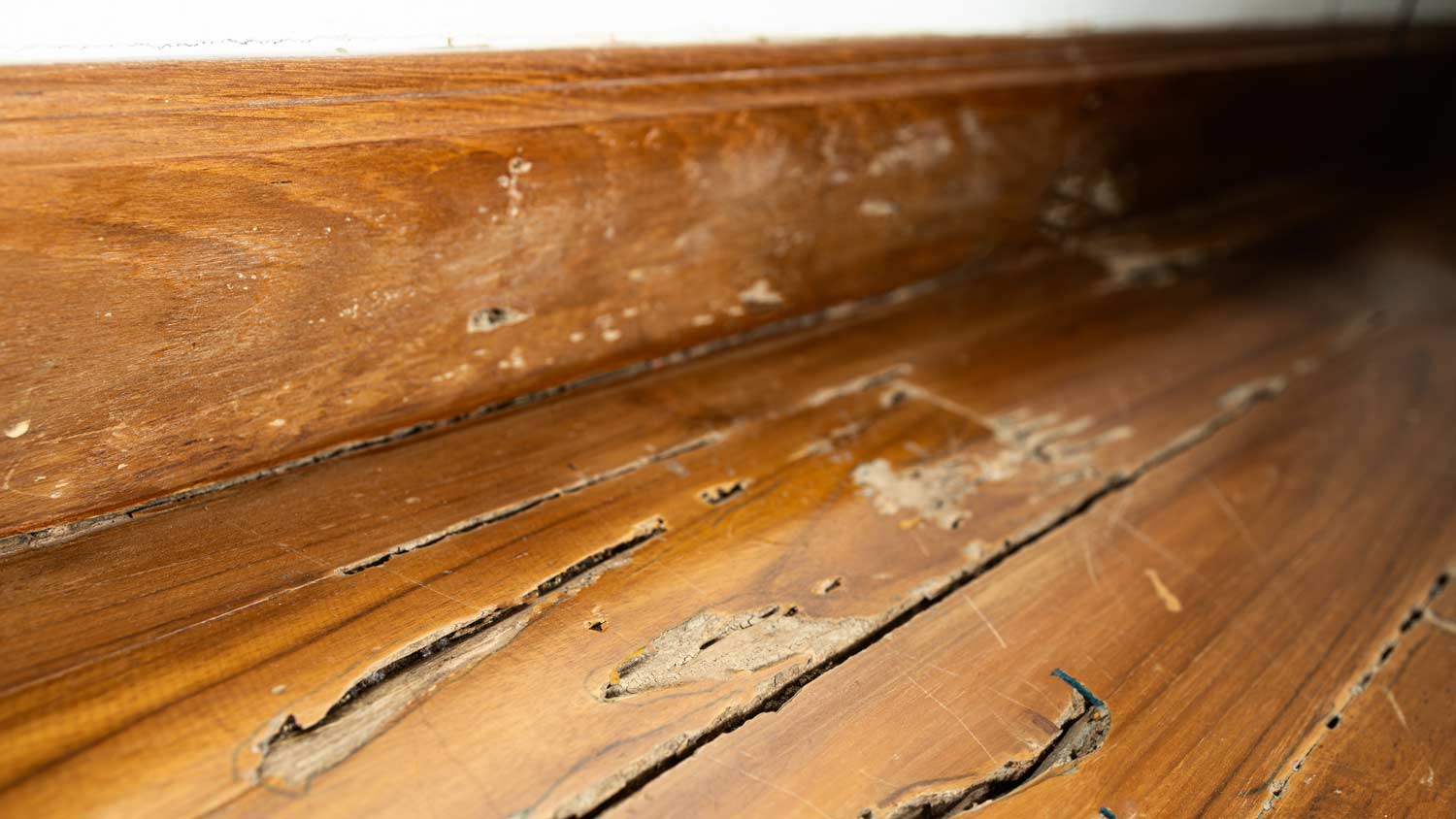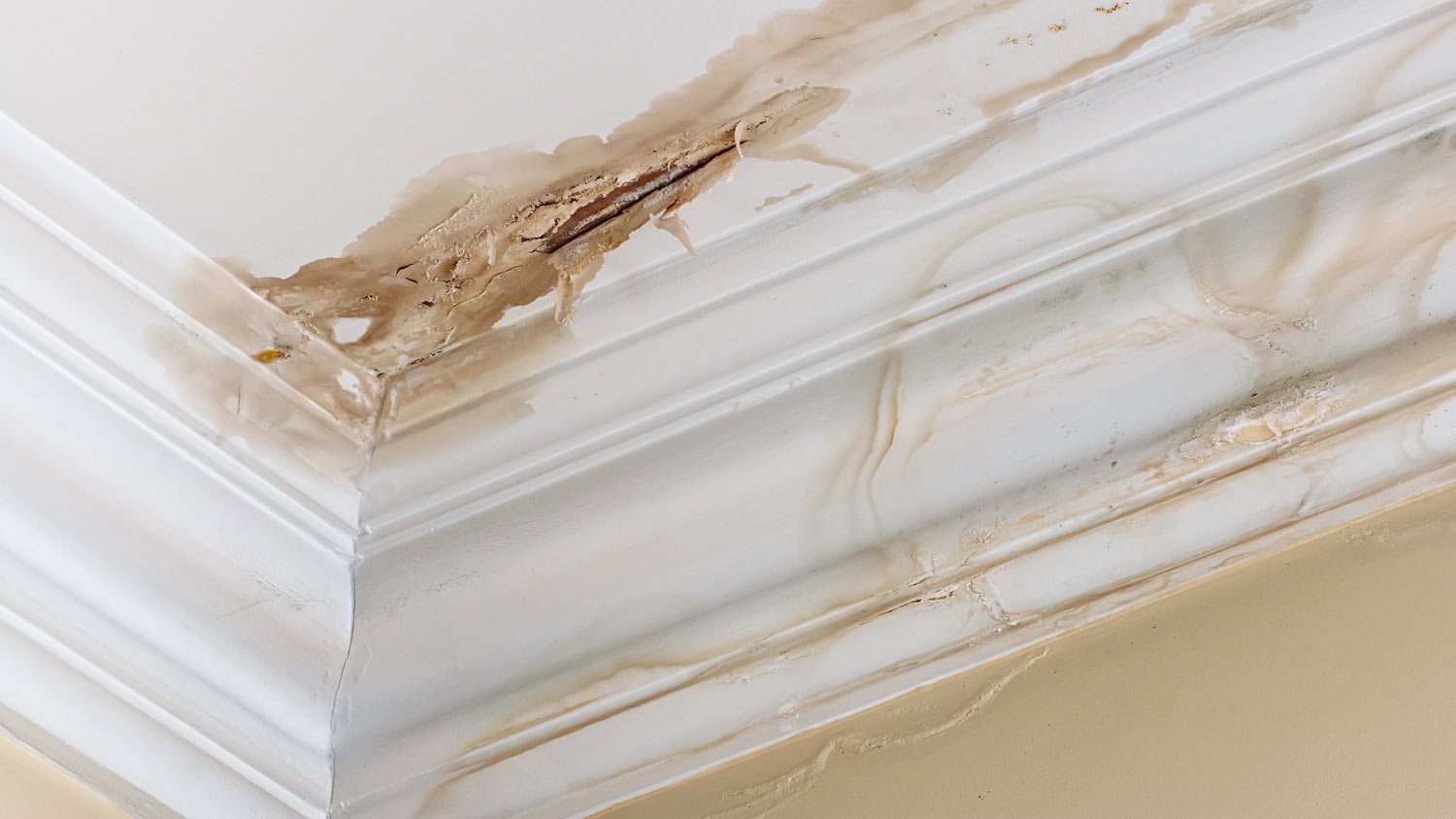
Fire damage restoration costs vary widely based on the extent of the damage. Learn how to assess your home and estimate your total after a fire.
Water and termites are two of wood’s biggest enemies


Water damage usually appears as square-shaped “cells” while termite damage looks like small, round holes.
Knocking on termite-damaged wood sounds hollow while water-damaged wood sounds solid.
Bubbling or peeling paint are signs of damage that can come from both water damage and termite damage.
You’ll need professional services to repair both water and termite damage.
Water damage and termite damage are two things that every homeowner hopes they never have to deal with. At first glance, the signs may look similar, but a deeper dive will help you uncover the root of the problem and keep your home from crumbling. In this guide, we’ll break down the differences between water vs. termite damage so you can plan a quick, effective fix.

Signs of water damage include buckling or swelling wood, dark spots on building materials, mold growth, musty odors, unusually high humidity levels, soggy drywall, and sagging insulation. On wood, water damage creates rectangular cells on the surface, and knocking on water-damaged wood makes a dense, solid sound. With termite damage, meanwhile, you’ll see circular holes or tunneling on wood and drywall, and you’ll notice a hollow sound when you knock on affected surfaces. You may also notice that wood is weakened to the point that you can puncture it with a screwdriver.
| Type of Difference | Water Damage | Termite Damage |
|---|---|---|
| Signs | Mold or fungus | Mud tunnels |
| Shape | Square-shaped “cells” | Small, round holes |
| Color | Yellow or dark | No discoloration |
| Feel | Soft and spongy | Brittle |
| Sound | Solid | Hollow |
| Smell | Musty odor | No odor |

It’s surprisingly easy to look at termite damage and wood rot from water damage and mistake one for the other. Both problems can cause paint to bubble and peel away from wood, but there are a few key differences in their appearance, namely shape, color, and signs of damage, that can help you identify the issue.
Water-damaged wood is characterized by a square-shaped “cell” pattern called cubicle rot. If it’s hard to envision, imagine the scales you’d see on an alligator’s back. Also called “alligatoring,” it usually starts as slight cracks before growing into wider and deeper patterns that look like alligator skin.
As termites eat their way through wood, they create small, round holes that are visible from the surface and look distinct from the rectangular pattern you’d see on water-damaged wood. You may also see cylindrical tunneling on the surface of wood where termites have fed.
Water damage on walls and wood can cause the areas to darken or become slightly yellow, while termite damage often causes little to no discoloration.
On the walls of your home, water damage and termite damage can look identical. The behind-the-scenes damage can cause bubbling or peeling paint; however, water damage typically presents with water stains as well, while termite damage can leave small holes in drywall where the pests ate through to the surface.
Houses are surrounded by tons of wood whether it’s in the walls, adorning a wooden entryway, or making up the landscape in the backyard. Extensive water damage on wood usually shows up as fungus and mold. Mold grows in a circular pattern with a fuzzy appearance. When checking for mold, the color can vary, but it’ll usually be white, green, or black.
Signs of termite damage include mud tunnels around the perimeter of your home. These are linear growths made up of dirt and termite droppings, or “frass,” that termites use to travel into your living space. On the termite-damaged wood itself, you’ll usually find circular holes and tunneling, and you may notice small piles of frass that look like piles of sawdust under the damaged area.
There are many things that can cause water damage, including a flood from an extreme weather event, water intrusion from a window or roof leak, an internal plumbing leak behind a wall, or even high levels of humidity in a poorly ventilated bathroom. Foundation leaks are another potential cause of water damage, which will leave you with symptoms of water damage in your crawl space or basement.
Termite damage, of course, is caused by termites, which are attracted to moisture and decaying wood. Termites may be drawn to an area near your home where wood is rotting, like a pile of firewood, a decaying tree stump, or even dead tree roots beneath the ground. Once they’ve consumed that wood source, they’ll often move inside your home to continue feeding. Even if you don’t have decaying wood near your home, termites can enter if you have a source of moisture inside, like a minor plumbing leak or a humid basement.
When you touch wood, the way it feels can indicate whether you’re dealing with water or termite damage.
Water damage weakens wood and its structural integrity, causing it to become soft and spongy to the touch. This can also be a result of dry rot, which occurs when airborne spores latch onto damp wood and begin growing. If you press on the wood and feel it give but not collapse, you likely have water damage.
Termites also cause significant wood damage, but they weaken the wood by eating away at the inside and hollowing it out. If you press on wood with minor termite damage, it will still feel hard and not be spongy. If there’s major termite damage, you may be able to stick a screwdriver through the wood, as it gets brittle with ongoing termite damage.
Knocking on wood does more than keep you from jinxing yourself. It’s an easy trick to identify the type of damage you’re dealing with so you can call the right professional to fix your problem.
Water-damaged wood doesn’t have an unusual sound, and it should sound solid. Because termites eat through your wood, there are likely multiple areas of wood missing. And when your wood is hollow, it’ll create a hollow sound if you knock on it.
Smell can be a decent indicator of water damage vs. termite damage, although they share some similarities, so you can’t use it as a standalone technique to confirm one over the other. Minor termite damage has no smell at all, but major termite damage can leave a musty odor behind. Water damage is characterized by a musty smell, too, but you’re more likely to experience an intense moldy odor rather than mustiness.
Fixing water damage and termite damage often requires extensive work at the hands of qualified professionals, but there are some differences in the process.
The first step in the water damage restoration process is to stop the leak or the source of water to minimize the water damage. A local water damage restoration company will then pump out standing water, vacuum up puddles, and run blower fans and dehumidifiers for 24 to 72 hours to dry everything out. Finally, the water damage restoration company you hire will remove unsalvageable materials and carry out repairs and replacements.
Water damage repair costs an average of $3,800, and most homeowners pay somewhere between $1,350 and $6,300.
The first step in repairing termite damage is to get rid of the termites. It’s best to hire a termite control specialist who’ll come ready with the right chemicals and tools to exterminate them and set up bait traps outside to prevent them from re-entering your home.
Depending on how long a termite colony has been eating its way through your home, the damage can vary from minimal to extensive. Minor damages can be solved with quick DIY projects that include cosmetic fixes like sanding, repainting, and refinishing affected surfaces. Extensive damages will require hiring a contractor to build or repair the damaged parts of your home. You may need major repairs if the termites damaged structural components.
Finally, you’ll need to figure out where the termites came from and get rid of whatever attracted them. If a termite infestation is affecting your trees, you’ll need to hire an arborist to conduct a tree inspection to see if you need to remove any from your yard. If the arborist recommends removal, a local tree debris removal service can handle the removal and disposal of the tree for you.
Termite damage repair costs an average of $3,000, and prices can range from $1,000 to $10,000, depending on the severity.
From average costs to expert advice, get all the answers you need to get your job done.

Fire damage restoration costs vary widely based on the extent of the damage. Learn how to assess your home and estimate your total after a fire.

Fire hydrant costs might not be an expense you think about day-to-day, but they’re important to consider for the safety of your home.

Water damage restoration costs depend on the severity of the problem, the type of water, and the length of time the damage has been occurring.

The type of smoke your home is exposed to will affect the kind of damage it leaves behind. Learn about the four types of smoke damage and how they differ.

Restoring water damage can be a lengthy and expensive process. Learn how long water damage restoration takes and what can affect your timeline.

Worried about water-damaged flooring? Learn the signs of water damage, how to clean it up, and what to do if cleaning doesn’t work.